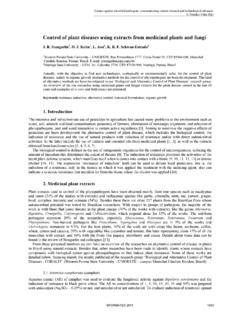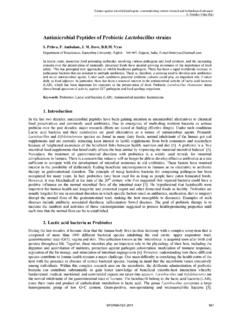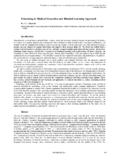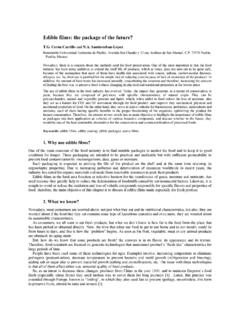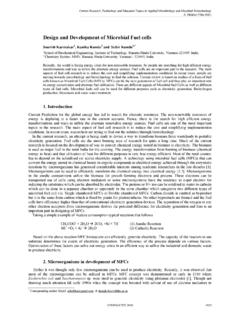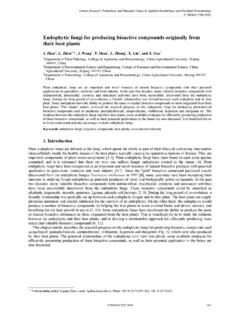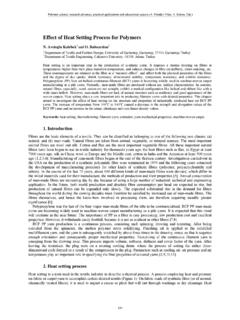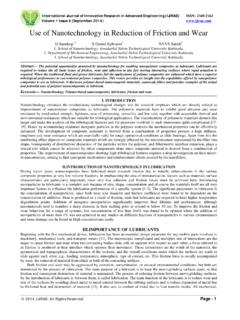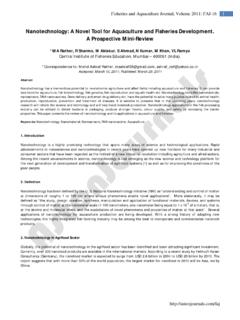Transcription of The use of nanotechnology as an approach for essential oil ...
1 Microbial pathogens and strategies for combating them: science, technology and education (A. M ndez-Vilas, Ed.). _____. The use of nanotechnology as an approach for essential oil- based formulations with antimicrobial activity A. S o Pedro1,* I. Espirito Santo1, C. V. Silva1, C. Detoni2 and E. Albuquerque1. 1. PEI, Escola Polit cnica, Universidade Federal da Bahia, Rua Aristides Novis, 2, Federa o, 40210-630, Salvador, Bahia, Brazil 2. Departamento de Sa de, Universidade Estadual de Feira de Santana, Av. Universit ria, s/n Km 03 da BR 116, VI. M dulo, Campus Universit rio, 44031-460, Feira de Santana, Bahia, Brazil The resistance of the bacteria and fungi to the innumerous antimicrobial agents constitutes one of the great challenges in the treatment of infections, conditioning to the necessity of searching and finding new sources of substances with antimicrobial properties.
2 essential oils are aromatic oily liquids that can be obtained from several parts of the plants Known for their medicinal properties, mainly antimicrobial , these kind of compounds can easily undergo oxidation reactions resulting in allergenic products and/or products with less biological activity . The nanoencapsulation of these oils in drug delivery systems have been proposed due to their capability of improving the solubility, stability and efficacy of essential oil- based formulations, by maintenance of therapeutic drug blood levels. Among them, polymeric nanoparticulate formulations have been extensively studied with significant improve of the essential oil antimicrobial activity .
3 Similar results also were obtained on studies focusing on lipid carriers, including liposomes, solid lipid nanoparticles, as well as nanoemulsions. Furthermore, other innovative carriers have been applied providing interesting results. Keywords essential oils; antimicrobial ; nanotechnology 1. essential Oils essential oils (EOs) are volatile, natural, aromatic oily liquids that can be obtained from several parts of the plants especially the aerial ones as leaves and flowers. They are derived from complex metabolic pathways in order to protect the plant organism from diverse pathogenic microorganisms, to repel insects that act as plague vectors, to reduce the appetite of some herbivorous by conferring unpleased taste do the plant.
4 Taking into account the strong sensitivity of insects to smells, the EOs generally facilitate the plant reproduction by attraction of specific insects that favour the dispersion of pollens and seeds [1]. Due to the aromatic feature of EOs, they have been widely used in industries for the production of soaps, perfumes and toiletries. On the other hand is remarkable their prospection and application as therapeutic products by folk medicine since middle ages. In observance to the popular faith oh the medicinal properties of EOs, a series of ethnopharmacological investigations has been evidenced their application for treatment of a wide range of pathological conditions [2, 3].
5 In fact, the large bioactivity of EOs has being confirmed by several studies, including antibacterial, antiviral, anti-inflammatory, antifungal, antimutagenic, anticarcinogenic, and antioxidant as well as other miscellaneous activities [4]. The extensive panel of biological activities of EOs can be linked to the complexity and variability of their chemical composition. Several factors can affect the final composition of this natural product. Different parts of the plant are composed by different systems and cell lines with different and extensive metabolic pathways involved on the production these oils.
6 Beyond leaves and flowers, the extraction of EOs can be carried out from fruits, seeds, stems, barks, roots, rhizomes, gums and oleoresin exudations. Taking into account the seasonal variation of environmental conditions of the nature during the year, it is also highly important the period of the year when is harvested the plant material for oil extraction. The nutrients available for plant growth have a crucial role on the definition the biochemical reactions on plant organelles, as well as, the exposition to light, the environmental temperature and water supply. Aware of these factors, the artificial cultivation of the plants for EO production must take in consideration a large list of variables [5].
7 All of these incognitos justify the existence of EOs with different compositions from the same plant material, there are several chemotypes for the same oil. Different methods of preparation can also provide different EOs. Some of the oldest techniques for EO production are steam and hydrodistillation [6]. The first documents describing distillation are dated from the 9th century. Imported into Europe by the Arabs, the concept of EOs was limited to distilled aromatic waters obtained from plants treat with alcohol. In the 16th century the notions of fatty oils and EOs, as well as the methods for separating essences from aromatic waters, became established.
8 In these methods the EO released from the plant material by heating are carried by aqueous vapour and after mutual condensation occurs the separation between aqueous and oily drops. Extraction methods mediated by organic solvents are also applied, however considering the high toxic potential of this kind solvents, alternatives have been pursued, such as inert gases and innocuous supercritical fluids. From a general point of view, the plant metabolites present in the EOs are comprised among terpenes and terpene derivatives formed via acetate-mevalonic acid pathway, aromatic compounds via shikimic-phenylpropanoid route and others molecules derived from miscellaneous origin.
9 Oxygenated constituents comprising various moieties are mainly 1364 FORMATEX 2013. Microbial pathogens and strategies for combating them: science, technology and education (A. M ndez-Vilas, Ed.). _____. responsible for providing taste and odour to essential oil. Among terpenes, the monoterpenes, sesquiterpene and diterpenes represent the major constituents of EOs which can be found accumulate in cell cytosol, vacuoles of epidermal cells, mesophyll cells and glandular cells of the plant. Due to the typical small size and apolar nature of monoterpene molecules they readily diffuse through cell membranes, as well as skin layers which enables their use as permeation enhancers for active pharmaceutic ingredients [7] The monoterpenes are composed of two branched, unsaturated C5 units (isoprene), having a molecular weight of 136amu.
10 The sesquiterpenes are composed of three isoprene units, counting a molecular weight of 204amu. There are more than 10,000 kinds of sesquiterpenes with a broad range of biological activities. The terpenoids, derived from oxygenation reaction routes of terpenes, including aromatic and aliphatic acid esters, alcohol and phenolic compounds, are associated to a large list of biological activities [8, 9]. antimicrobial Profile of essential Oils The literature demonstrates a plenty of studies overviewing the remarkable performance of EOs as antimicrobials. In vitro and in vivo studies have been confirming what ethnopharmacological studies have been found in the folk knowledge: an enormous number of EOs exhibits exceptionally good activity against bacteria, yeasts and filamentous fungi.
